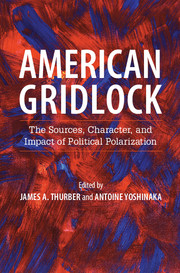Book contents
- Frontmatter
- Dedication
- Contents
- List of contributors
- Foreword
- Acknowledgments
- Introduction
- PART I POLARIZATION AMONG VOTERS AND ACTIVISTS
- PART II POLARIZATION IN NATIONAL INSTITUTIONS
- PART III POLARIZATION IN THE STATES
- PART IV POLARIZATION IN THE MEDIA
- 12 Partisan Media and Electoral Polarization in 2012: Evidence from the American National Election Study
- 13 News as a Casualty: District Polarization and Media Coverage of U.S. House Campaigns
- 14 More a Symptom Than a Cause: Polarization and Partisan News Media in America
- 15 The Polarizing Effects of Partisan and Mainstream News
- PART V IMPLICATIONS AND CONCLUSIONS
- Index
- References
13 - News as a Casualty: District Polarization and Media Coverage of U.S. House Campaigns
from PART IV - POLARIZATION IN THE MEDIA
Published online by Cambridge University Press: 05 November 2015
- Frontmatter
- Dedication
- Contents
- List of contributors
- Foreword
- Acknowledgments
- Introduction
- PART I POLARIZATION AMONG VOTERS AND ACTIVISTS
- PART II POLARIZATION IN NATIONAL INSTITUTIONS
- PART III POLARIZATION IN THE STATES
- PART IV POLARIZATION IN THE MEDIA
- 12 Partisan Media and Electoral Polarization in 2012: Evidence from the American National Election Study
- 13 News as a Casualty: District Polarization and Media Coverage of U.S. House Campaigns
- 14 More a Symptom Than a Cause: Polarization and Partisan News Media in America
- 15 The Polarizing Effects of Partisan and Mainstream News
- PART V IMPLICATIONS AND CONCLUSIONS
- Index
- References
Summary
Although scholars have noted a variety of consequences of polarization – from legislative gridlock to a decline in political comity to increasingly negative views of government – virtually no work has considered district polarizatione's effects on local political news coverage. Using an original, detailed content analysis of local newspaper coverage from every congressional district during the 2010 midterms, we examine how district polarization shapes media coverage of U.S. House races. The data reveal that:
• District polarization affects the competitive context of House campaigns. Lopsided districts – those safe for one party – are less likely than more evenly split districts to see competitive contests.
• Competitiveness then influences the attention congressional races receive from the news media. Districts that are lopsided see less coverage than more evenly split districts do.
• Competitiveness also affects the substance of local news coverage in U.S. House campaigns. The more competitive the race is, the more substantive coverage there is. This is true whether we examine the number of stories that mention both candidates, the number of issue mentions across the campaigne's coverage, or the number times the candidates’ personal traits are discussed in the coverage.
By linking polarization to competitiveness, and competitiveness to news coverage, we show that polarization impoverishes the news environment. These findings are consequential because a growing body of research suggests that a diminished news environment can depress citizens’ political knowledge and engagement.
INTRODUCTION
When Carol Shea-Porter and Frank Guinta took the debate stage at Saint Anselm College on a mid-October day in 2010, most voters in New Hampshiree's 1st Congressional District already knew where the two candidates stood. Shea-Porter, the two-term Democratic incumbent vying to keep her seat, surprised no one in the audience when she blamed the Bush administration for the struggling national economy and persistent federal budget deficits. She was just repeating a central theme in her months-long campaign. “The reality is that when the Republicans came into power,” she said, “we were running a surplus.” And when Guinta lambasted Shea-Portere's support for the 2009 stimulus package that had promoted only anemic job growth in New Hampshire as “not effective management of money,” debate watchers could have guessed his next line. The Republican former mayor of Manchester had been making the same argument since he entered the race.
- Type
- Chapter
- Information
- American GridlockThe Sources, Character, and Impact of Political Polarization, pp. 287 - 308Publisher: Cambridge University PressPrint publication year: 2015



